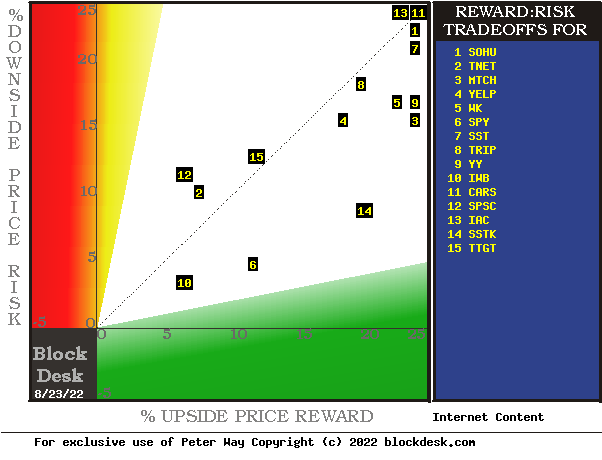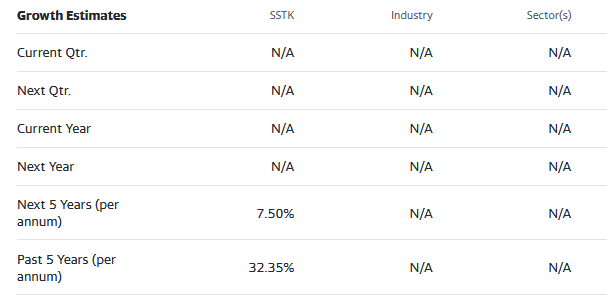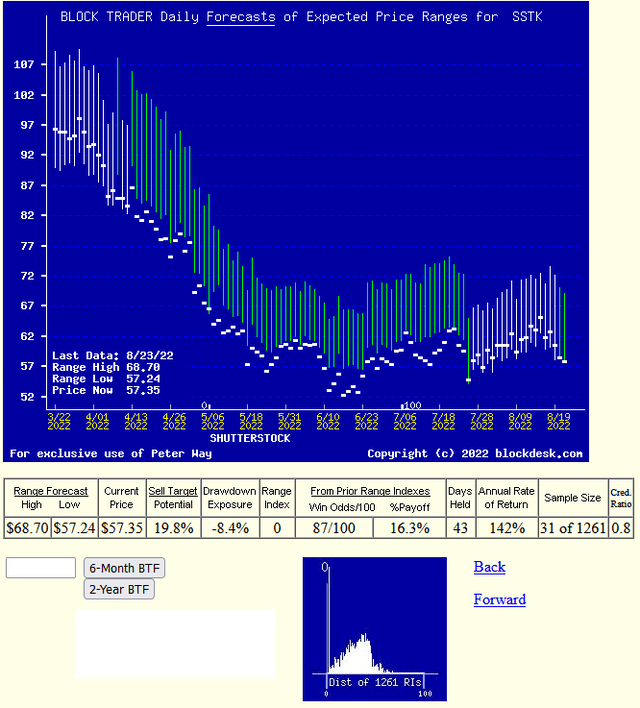

Pgiam/iStock via Getty Images
Pgiam/iStock via Getty Images
Knowing when and which stocks to own, actively and selectively, provides a continuing series of net capital gain opportunities delivering wealth accumulation or spendable income at rates which are multiples of what market-index ETFs offer.
You can know what winning institutions know about capital-building stock situations by listening to what the markets tell as capital is being invested. Because today’s markets pay active investors for being in the right places at the right times. They feed off the indolence of passive-strategy investing buy and holders who frequently pass-up timely points of profitable position liquidation.
Increased information technology, communication capabilities, and rapidly evolving competitive practices make this century’s investing markets far more opportune with pricing activity than the 20th century offered.
But an active investment strategy requires reasonably-accurate forecasts of what to expect. Fortunately, the conditions creating the “hazards” feared by the buy and holders are what provide the needed forecasts. The markets themselves, in their interactions, define what the best-informed professional practitioners see as coming-price limits. In both directions.
Instead of forecasts by analysts of what may be hoped for as price/earnings targets to be sought, the markets define ranges within which prices are reasonably being expected. Ranges which warn of currently un-maintainable excesses, and of price depressions unlikely to present buying bargains for long.
But if this is not a suitable practice for your situation, continue to ignore it. We are pleased to have your persistent support, rather than competition which might erode our wealth-building competitive productivity.
Let’s look at an “Opportunity Set” of comparable companies ranging from most to least attractive to consider in one particular area of activity today – the Internet as a means of getting things done. Our best-buy bet is Shutterstock, Inc. (NYSE:SSTK). Here in Figure 1 is how the markets currently appraise their Reward-Risk trade-offs.
Figure 1

blockdesk.com
blockdesk.com
(used with permission)
Upside price rewards are from the behavioral analysis (of what system transactions require to be done, not of emotional investor errors) by Market-Makers (MMs) as they protect their at-risk capital from possible damaging future price moves. Their potential reward forecasts are measured by the green horizontal scale.
The risk dimension is of actual price drawdowns at their most extreme point while being held in previous pursuit of upside rewards similar to the ones currently being seen. They are measured on the red vertical scale.
Both scales are of percent change from zero to 25%. Any stock or ETF whose present risk exposure exceeds its reward prospect will be above the dotted diagonal line. Capital-gain attractive to-buy issues are in the directions down and to the right.
Our principal interest is in SSTK at location [14]. A “market index” norm of reward~risk tradeoffs is offered by SPY at [6]. Most appealing by this Figure 1 view is SSTK.
“Shutterstock, Inc., a technology company, provides quality content, and creative workflow solutions in North America, Europe, and internationally. It offers image services consisting of photographs, vectors, and illustrations, which are used in visual communications, footage services, including video clips, filmed by industry experts and cinema-grade video effects; and music services which are used to complement images and footage. It serves corporate professionals and organizations, media and broadcast companies, and small and medium-sized businesses, and individual creators. The company was founded in 2003 and is headquartered in New York, New York.”
Source: Yahoo Finance

Yahoo Finance
Yahoo Finance
These growth estimates have been made by and are collected from Wall Street analysts to suggest what conventional methodology currently produces. The typical variations across forecast horizons of different time periods illustrate the difficulty of making value comparisons when the forecast horizon is not clearly defined.
The Figure 1 map provides a good visual comparison of the two most important aspects of every equity investment in the short term. There are other aspects of comparison which this map sometimes does not communicate well, particularly when general market perspectives like those of SPY are involved. Where questions of “how likely’ are present other comparative tables, like Figure 2, may be useful.
Figure 2

blockdesk.com
blockdesk.com
(used with permission)
Figure 2’s purpose is to attempt universally comparable answers, stock by stock, of a) How BIG the prospective price gain payoff may be, b) how LIKELY the payoff will be a profitable experience, c) how SOON it may happen, and d) what price drawdown RISK may be encountered during its active holding period.
Readers familiar with our analysis methods after a quick examination of Figure 2 may wish to skip to the next section viewing price range forecast trends for SSTK.
Column headers for Figure 2 define investment-choice preference elements for each row stock whose symbol appears at the left in column [A]. The elements are derived or calculated separately for each stock, based on the specifics of its situation and current-day MM price-range forecasts. Data in red numerals are negative, usually undesirable to “long” holding positions. Table cells with yellow fills are of data for the stocks of principal interest and of all issues at the ranking column, [R].
The price-range forecast limits of columns [B] and [C] get defined by MM hedging actions to protect firm capital required to be put at risk of price changes from volume trade orders placed by big-$ “institutional” clients.
[E] measures potential upside risks for MM short positions created to fill such orders, and reward potentials for the buy-side positions so created. Prior forecasts like the present provide a history of relevant price draw-down risks for buyers. The most severe ones actually encountered are in [F], during holding periods in an effort to reach [E] gains. Those are where buyers are emotionally most likely to accept losses.
The Range Index [G] tells where today’s price lies relative to the MM community’s forecast of upper and lower limits of coming prices. Its numeric is the percentage proportion of the full low to high forecast seen below the current market price.
[H] tells what proportion of the [L] sample of prior like-balance forecasts have earned gains by either having price reach its [B] target or be above its [D] entry cost at the end of a 3-month max-patience holding period limit. [ I ] gives the net gains-losses of those [L] experiences.
What makes SSTK most attractive in the group at this point in time is its ability to produce capital gains most consistently at its present operating balance between share price risk and reward at the Range Index [G]. At a RI of zero, today’s price is at the bottom of its forecast range, with price expectations all to the upside. Not our expectations, but those of Market-Makers acting in support of Institutional Investment organization clients building the values of their typical multi-billion-$ portfolios.
Credibility of the [E] upside prospect as achieved previously at today’s RI in the [I] payoff at +16% is shown in [N].
Further Reward~Risk tradeoffs involve using the [H] odds for gains with the 100 – H loss odds as weights for N-conditioned [E] and for [F], for a combined-return score [Q]. The typical position holding period [J] on [Q] provides a figure of merit [fom] ranking measure [R] useful in portfolio position preferencing. Figure 2 is row-ranked on [R] among alternative candidate securities, with SSTK in top rank.
One important notion from this analysis is that much of internet content, despite its appealing presence and enthusiastic presentation provides little revenue-generating investment opportunity. Hot spots may get intense, but they are relatively few and are likely to vacillate through time.
Along with the candidate-specific stocks these selection considerations are provided for the averages of some 3,300 stocks for which MM price-range forecasts are available today, and 20 of the best-ranked (by fom) of those forecasts, as well as the forecast for S&P500 Index ETF as an equity-market proxy.
Current-market index SPY is only moderately competitive as an investment alternative. Its Range Index of 34 indicates some two-thirds of its forecast range is to the upside while only a bit more than three-quarters of previous SPY forecasts at this range index produced profitable outcomes.
As shown in column [T] of figure 2, the levels vary significantly between stocks. What matters is the net gain between investment gains and losses actually achieved following the forecasts, shown in column [I]. The Win Odds of [H] tells what proportion of the Sample RIs of each stock were profitable. Odds below 80% often have proven to lack reliability.
Figure 3

blockdesk.com
blockdesk.com
(used with permission)
Many investors confuse any time-repeating picture of stock prices with typical “technical analysis charts” of past stock price history. These are quite different in their content. Instead, here Figure 3’s vertical lines are a daily-updated visual record of price range forecast limits expected in the coming few weeks and months. The heavy dot in each vertical is the stock’s closing price on the day the forecast was made.
That market price point makes an explicit definition of the price reward and risk exposure expectations which were held by market participants at the time, with a visual display of their vertical balance between risk and reward.
The measure of that balance is the Range Index (‘RI’). Now the full low to high forecast lies above the current market price.
With today’s RI there is 19.8% upside price change in prospect. Of the prior 31 forecasts like today’s RI, 28 have been profitable, some 7 out of every 8. The market’s actions of prior forecasts became accomplishments of +16.3% gains in 43 market days., or 8+ weeks. So history’s advantage could be repeated nearly six times in a 252 market-day year, which compounds into a CAGR of +142%.
Also please note the smaller low picture in Figure 3. It shows the past 5-year distribution of Range Indexes with the current level visually marked. For SSTK nearly all recent past forecasts have been of higher prices and Range Indexes. And importantly once market prices, compared to MM forecasts, have reached a RI level much above 50 the odds of going higher become slight – it’s likely to be time to reinvest elsewhere.
Based on direct comparisons with other Internet Content participants, there are strong wealth-building reasons to prefer a capital-gain seeking buy in Shutterstock, Inc. over other examined alternatives.
This article was written by
Disclosure: I/we have no stock, option or similar derivative position in any of the companies mentioned, but may initiate a beneficial Long position through a purchase of the stock, or the purchase of call options or similar derivatives in SSTK over the next 72 hours. I wrote this article myself, and it expresses my own opinions. I am not receiving compensation for it (other than from Seeking Alpha). I have no business relationship with any company whose stock is mentioned in this article.
Additional disclosure: Additional disclosure: Peter Way and generations of the Way Family are long-term providers of perspective information, earlier helping professional investors and now individual investors, discriminate between wealth-building opportunities in individual stocks and ETFs. We do not manage money for others outside of the family but do provide pro bono consulting for a limited number of not-for-profit organizations.
We firmly believe investors need to maintain skin in their game by actively initiating commitment choices of capital and time investments in their personal portfolios. So our information presents for D-I-Y investor guidance what the arguably best-informed professional investors are thinking. Their insights, revealed through their own self-protective hedging actions, tell what they believe is most likely to happen to the prices of specific issues in coming weeks and months. Evidences of how such prior forecasts have worked out are routinely provided, both on blockdesk.com and on our Seeking Alpha Contributor website. Pls see SA articles numbered 1495621 and 1936131.







